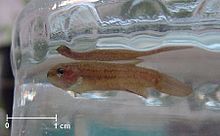- Oodinium
-
Oodinium Scientific classification Kingdom: Chromalveolata Phylum: Dinoflagellata Class: Blastodiniphyceae (or Dinophyceae) Order: Blastodiniales Family: Oodiniaceae Genus: Oodinium Species Oodinium limneticum
Oodinium pillularis
Oodinium pouchetiiOödinium (also known as Piscinoodinium) is a genus of microscopic parasitic dinoflagellates. They live off salt and fresh water fish, causing a type of fish velvet disease (also called gold dust disease). One species has also been recorded on various cnidarians [1].
The host typically develops small yellow or gold dust scattered on its head, fins and body. At this stage, the infestation is already severe. The attack usually starts at the gills at which stage it is difficult to notice. The host is irritated and often swims in fuzziness while rubbing itself against rocks. The yellowish spots are more vivid under sunlight or flashlight. It is very similar to Ichthyophthirius, though the oodinium spots are yellowish and smaller.
The life cycle of oodinium starts as a dinospore that swims in the water to look for a suitable host. As it attaches itself onto the host skin, it forms a hard shell protecting itself against the outside environment while it is eating the fish skin cells. This is the cyst stage seen as dust covering the fish skin. After few days, the cyst sinks to the bottom, freeing new generation of dinospores. And the cycle repeats. The dinospore must find a host within 48 hours, otherwise the dinospore would die.
Treatment is possible by diluting the commercially available copper salts. Free swimming dinospore is extremely vulnerable to copper. Bringing the water temperature to 30°C helps to release the dinospore from cyst.
See also
- Amyloodinium
- Pfiesteria
External links
Categories:- Dinoflagellates
Wikimedia Foundation. 2010.

